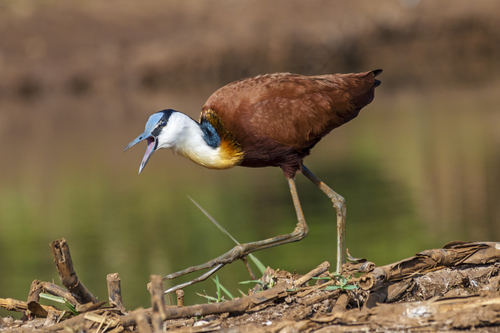
African Jacana
The African jacana, with its long-toed feet, dances gracefully over water lilies. This vibrant bird, adorned in chestnut and blue, thrives in sub-Saharan wetlands. Notably polyandrous, the female courts multiple males, entrusting them with nurturing duties, showcasing unique gender dynamics in avian life.
5-10 years
Lifespan
113.4 - 340.2 g
Weight
Length: 23 - 30 cm
Size
Brown, Yellow, Blue, Black, White
Color
Least Concern
Conservation Status
Stable
Population Trend
Characteristics
The African jacana, Actophilornis africanus, is a striking bird with long toes and claws that enable it to walk on floating vegetation in shallow lakes. It exhibits vibrant chestnut plumage, a bright blue frontal shield, and a distinct black crown. This species is known for its polyandrous breeding system, where females mate with multiple males, who then incubate the eggs and care for the young. Found across sub-Saharan Africa, the African jacana plays a crucial role in its ecosystem by controlling insect populations.
Distribution Range of the African Jacana
The Actophilornis africanus, commonly known as the African jacana, is native to sub-Saharan Africa. Its geographical distribution spans a wide range, including countries from Senegal and Sudan in the north, to South Africa in the south, as well as across the central and eastern regions of the continent.
African Jacana's Habitat
Environmental Conditions
The African jacana typically inhabits freshwater wetlands, including lakes, ponds, and marshes. These environments are characterized by shallow water bodies rich in floating vegetation, which the jacanas utilize for foraging and breeding.
Ecological Niche
The species is well-adapted to life on floating vegetation, with elongated toes and claws that allow it to walk on lily pads and other aquatic plants. This adaptation is crucial for their feeding strategy, which involves picking insects and other invertebrates from the water's surface and vegetation.
Copyright @ Nature Style Limited. All Rights Reserved.
 English
English